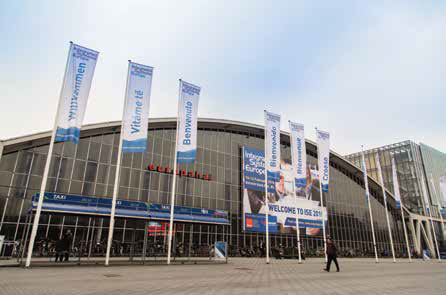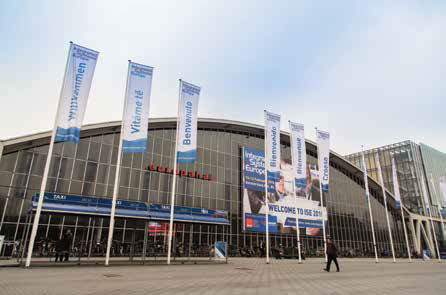ISE 2016: a Powerhouse of Trends, Products, Technologies

Ah—the AV world beyond our cozy United States. So much more geography, so much in common, so much more to share. Clearly, these two little words best succinctly encapsulate all that I experienced at Integrated Systems Europe 2016.

The Amsterdam RAI was host to the Integrated Systems Europe 2016 expo. One of our greatest benefits here at SCN when it comes to covering a show on the scale of ISE is that we are fortunate to have several of our sister publications on site producing all types of content, including our colleagues at Installation magazine in the UK with a full team of reporters producing the official ISE Show Daily. As such, we have chosen to share some of the technology trends highlighted by our teammates across the industry. I will focus here on my perceptions of the international business climate and some of the many interesting conversations and perspectives that I engaged in while covering most of the vast territory occupied at the Amsterdam RAI.
By all accounts, the international AV world is thriving. ISE’s attendance figures and floor space attest to this well. Several manufacturers were touting the growth or expansion of their businesses around the world. Geographic footprints are being expanded by InFocus, with a new EMEA briefing center and training facility opened, as well as recent acquisitions. Atlona is continuing to build on its international expansion with a Swiss facility recently opened and one in Asia coming down the pipeline. Peerless-AV established a new office that has brought “explosive” growth in Europe, according to Nick Belcore, EVP.
I heard about some varying sales strategies implemented in the international market. Oblong has taken cues from the dynamic it’s gone through in its North American sales channel, where they started off with direct sales, establishing an end user reputation. However, more recently, the enterprise collaboration solution provider has shifted to a partner reseller model. In EMEA, Oblong has chosen to focus on the partner model.

Customer demand for uniformity in AV systems worldwide were top of my mind for many. AVI-SPL expanded its virtual meeting room (VMR) to Canada, Europe, and Australia, as a result. With transactional sales of VMR, a sort of SMB DIY hybrid model has emerged, with the intent to cater to demands for increasing simplicity. On-site services have grown considerably for the industry’s largest integrator, especially in the United Kingdom.
Continuing along with the uniform global services theme, I conveniently stumbled into a happy hour with the Global Presence Alliance (GPA), where I learned they’re progressing in their mission of sharing and expanding resources throughout the alliance’s worldwide network of integrators. The alliance program director Mike Stead shared some specific geopolitical business challenges faced in the South American and Brazilian markets and how the GPA is addressing them from a group perspective. I also heard how ATEA, a Latvian GPA member, has developed a highly scaled multilingual call center, now available for the benefit of all 20-plus members worldwide.
Shifting to technology trends, projection mapping (along with lasers) made a big showing. Panasonic touted a recent white paper published, citing 50 percent growth in a 12-month period, including more spectacle type applications. Basically, we can expect projection mapping to be the new fireworks. More of these advanced projects are being developed as permanent installations as well.
A daily selection of the top stories for AV integrators, resellers and consultants. Sign up below.
Digital Projection stood out in a crowded field of projection displays by highlighting unorthodox shapes, focusing on manifestations that flat panels simply can’t achieve, all with laser projection. Sony showcased laser projection in a dome, with striking moving images of the Aurora Borealis. Epson demo’d its mapping technology artfully animating a race-car in its booth.
IP-related topics were, unsurprisingly, quite prevalent. The control room is slowly but surely coming along. While RGB Spectrum hasn’t seen a huge demand thus far for IP solutions in the control room, “it’s coming,” noted John Henkel, director of product marketing. RGB has first focused on reducing size and cost of existing solutions, like the MCMS Express control room management platform, as well as additional 4K flexibility with the Quadview UHD multiviewer. Matrox’s control room solutions have also gone the IP route. The introduction of the C900 video card adds the capability for up to nine connected displays at 1920x1200 resolution. Adder emphasized its use of Cisco and other general switches as a competitive difference in its real-time KVM switching solutions, bringing system cost down. The British KVM provider is readying its 4K solution next.
Some of my most high level conversations about IP and IT solutions came from audio distribution folks. QSC has been laser focused on catering to the IT centric AV world, working on software management tools for IT, and generally driving larger industry discussions. TJ Adams pointed out a few of IT’s least favorite terms (automagic was my favorite), and discussed how the broad idea of the network for integrators—that it’s like a home router, plug and play, etc.—couldn’t be further from the truth for the IT department. Customer needs should be where the dialog starts, he emphasized.
Alcorn McBride introduced the V-Page, an intelligent Dante public address station, for facility wide paging. An ethernet cable carries audio, power, and control between the V-Page and a rack. They are infinitely expandable once connecting to PoE-enabled network switches.
Pakedge is capitalizing on the AV/IP world, introducing three new switches, including the S3-24P layer 3 switch, adding to its line card of routers and wireless access points.
In the midst of Harman’s massive and comprehensive booth space, the SVSI visually lossless 4K compression stood out with a side-by-side comparison of what looked like two identical displays. The JPEG 2000-based compression format transported by AMX SVSI encoders and decoders over a standard gigabit network proves that you can have your cake and eat it too when it comes to providing 4K without sacrificing quality.
The most common conversation I had was about the technology enabling different spaces in the workplace. Biamp made a high profile launch with the Devio system, a peripheral hub and “collection point for technology in a room,” as stated by Rob Houston, collaboration manager. Its DTM1 beamforming mic along with Biamp AEC and noise reduction algorithms are what set the system apart.
It might seem unusual to peg Meyer Sound here with workplace spaces, but the audio specialist has really cleverly applied its Constellation system to business environments. It stood out as an audio demo actually ideal for a busy, humming tradeshow floor, and it’s a hearing is believing solution. I could attempt to do it justice with words, but really, do yourself a favor and prioritize this demo in your future. It will quite simply change the way you think about corporate installs.
For me, the biggest lesson I learned at ISE was the need for a flexible, hybrid workspace model. With the advent of the huddle room, every big and little AV manufacturer out there is heralding the pop-up collaboration area in an open office floor plan as the future. The truth of the matter is that we tend to latch on to tech trends and plow full steam ahead without enough practical user input guiding the way. The huddle space is a game changer, but viewing it as the end-all be-all of office space seems myopic. We need huddle rooms, the kinds with doors and without, and we still need boardrooms and other offices. Hybrid corporate AV floor-plans are the key to accommodating workplaces of all business types in the coming years.
As InFocus CEO Mark Housley described, integrating into the workflow, and making workflows more competitive, is what customers want today, and it’s the value that integrators bring to the table now. Which puts into context the fact that InFocus introduced an executive level videoconferencing solution, the ConX Exec system, along with the ConX Wall, supporting up to 96 displays, providing integrators with a thorough ecosystem of collaboration spaces.
Lindsey M. Adler is editor of SCN.
Lindsey M. Adler is an audiovisual storyteller based in New York.

